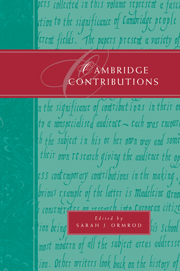Book contents
- Frontmatter
- Contents
- Notes on contributors and contributions
- Preface
- 1 Some Cambridge contributions to astronomy and cosmology
- 2 Cambridge's contribution to medical science
- 3 Cambridge and the study of English
- 4 The Cambridge contribution to economics
- 5 ‘Nasty forward minxes’: Cambridge and the higher education of women
- 6 Cambridge Classics for the third millennium
- 7 Cambridge contributions: the philosophy of science
- 8 European citizenship and education
- 9 The University Botanic Garden
- 10 Geophysics in Cambridge: extinct and active volcanoes
- 11 Cambridge spies: the ‘Magnificent Five’, 1933–1945
9 - The University Botanic Garden
Published online by Cambridge University Press: 31 December 2009
- Frontmatter
- Contents
- Notes on contributors and contributions
- Preface
- 1 Some Cambridge contributions to astronomy and cosmology
- 2 Cambridge's contribution to medical science
- 3 Cambridge and the study of English
- 4 The Cambridge contribution to economics
- 5 ‘Nasty forward minxes’: Cambridge and the higher education of women
- 6 Cambridge Classics for the third millennium
- 7 Cambridge contributions: the philosophy of science
- 8 European citizenship and education
- 9 The University Botanic Garden
- 10 Geophysics in Cambridge: extinct and active volcanoes
- 11 Cambridge spies: the ‘Magnificent Five’, 1933–1945
Summary
In the Classical and Medieval worlds collections of plants were held as the only source of the drugs which were used in medicine. Thus for those who were studying medicine, and subsequently practising, a detailed knowledge of plants was essential. We still today obtain more than 50 per cent of drugs directly from plants: chemical synthesis, although a powerful approach to drug production, is expensive and limited in its application. Plants are remarkable natural chemical factories and this has been exploited by mankind throughout his evolution.
In Renaissance Italy in the late sixteenth century, the new universities began to gather plant collections in order to have material on hand to teach students about the medicinal uses of plants. These botanic gardens, essentially physic gardens, were developed in the universities of the city states of Northern Italy - Padua, Lucca, Florence and Siena. Physic gardens spread north of the Alps to Leiden in the Low Countries, and then to Oxford in 1621. Cambridge had a strong tradition in medicine dating back to the Middle Ages and by the seventeenth century there was a clear necessity for a botanic garden for displaying and teaching about the plants which were used for the training of physicians.
Although the need for a botanic garden was discussed in Cambridge University in the middle of the seventeenth century, it was only in 1762 that the University eventually managed to assemble sufficient funds and a sufficient consensus to purchase a private garden in the centre of Cambridge for this purpose.
- Type
- Chapter
- Information
- Cambridge Contributions , pp. 169 - 185Publisher: Cambridge University PressPrint publication year: 1998



